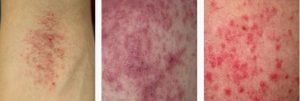A Look at Seborrheic Dermatitis
 Seborrheic dermatitis is a common condition that generally affects the scalp areas. It can cause dandruff, red skin, and scaly patches. The condition can also affect the oilier areas of the body, including the face, back, and upper chest. In infants, it can cause a condition known as “cradle cap”. The condition is also known as seborrheic psoriasis, seborrheic eczema, and dandruff.
Seborrheic dermatitis is a common condition that generally affects the scalp areas. It can cause dandruff, red skin, and scaly patches. The condition can also affect the oilier areas of the body, including the face, back, and upper chest. In infants, it can cause a condition known as “cradle cap”. The condition is also known as seborrheic psoriasis, seborrheic eczema, and dandruff.
The symptoms of seborrheic dermatitis include:
- Flakes of skin on your scalp, hair, eyebrows, beard or mustache
- Patches of greasy skin covered with flaky yellow or white scales. Crust on the scalp, ears, face, chest, armpits, scrotum or other parts of the body
- Redness of the skin
- Crusting or redness of the eyelids with possible itching or stinging
There are certain factors that increase your risk of developing seborrheic dermatitis including:
- ~A weakened immune system
- ~Neurological and psychiatric conditions
- ~Congestive heart failure
- ~Endocrine disease
- ~Certain medications
While this condition will not affect your general overall health, it can be an uncomfortable and embarrassing condition to deal with. However, you should know that seborrheic dermatitis is not contagious, nor is it an indication of poor personal hygiene.
Seborrheic dermatitis is a long-term condition and will require repeated, continued treatments. In addition, flare ups and symptoms may return.
If you have a mild case, there are several home remedies that may help you control this condition including:
- ~Washing your hair with medicated anti-dandruff shampoo
- ~Applying mineral or olive oil to your scalp to soften and remove scales
- ~Applying a mild corticosteroid cream
- ~Avoiding products containing alcohol as these can cause flare ups
- ~Consider shaving off a beard or mustache
You should consult with a doctor for more aggressive treatments if any of the symptoms cause:
- ~Sleep loss or being distracted from daily routines due to uncomfortable symptoms
- ~Anxiety or embarrassment
- ~Infections of the skin
- ~Unsuccessful self-care treatments
During your exam, your doctor may scrape off some skin cells for further examination to rule out conditions that have similar symptoms. These conditions can include psoriasis, eczema and rosacea.
Medical treatments for seborrheic dermatitis can include:
- ~Prescription-strength shampoos, ointments or creams that control inflammation
- ~Antifungal medications taken orally
- ~Antifungal shampoo that is alternated with stronger medication
- ~Medications that affect your immune system
- ~Light therapy in addition to medication
- ~Creams and gels that fight bacteria
